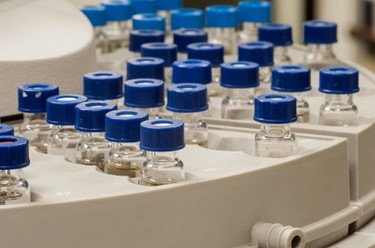BioPhorum: User Requirement Specification for Small, Flexible Filler Technology
A discussion with Joshua Durrin, Bayer; Rich Urban, Pfizer; Brian Halion, Merck; Justin Svec, Eli Lilly; and Mingh Luong, Genentech

The BioPhorum Operations Group, a cross-industry collaboration between biopharmaceutical manufacturers and their suppliers, has released a user requirement specification (URS) document for small, flexible filler technology. The document, developed by members of BioPhorum’s Fill Finish (FF) community, has been developed to provide equipment manufacturers with an overview of industry’s short-term needs, to inform and support the development of appropriate technology and reduce the need for customization.
Pharmaceutical Online asked several members of the BioPhorum FF group about the specific needs that led to the development of the URS, important requirements it specifies, how the document will benefit industry stakeholders, and next steps for the initiative.
Evolving Filling Technology Needs
 According to Joshua Durrin, principal engineer at Bayer, the biopharmaceutical industry is transitioning from an era of blockbuster drugs that treat large segments of the population with a common ailment, to one of more personalized/specialized medicines for much smaller patient populations. Consequently, manufacturing operations are evolving from large batches and high-speed filling lines aimed at driving down unit costs, to agile lines that can rapidly switch between various lower volume products line to maximize utilization.
According to Joshua Durrin, principal engineer at Bayer, the biopharmaceutical industry is transitioning from an era of blockbuster drugs that treat large segments of the population with a common ailment, to one of more personalized/specialized medicines for much smaller patient populations. Consequently, manufacturing operations are evolving from large batches and high-speed filling lines aimed at driving down unit costs, to agile lines that can rapidly switch between various lower volume products line to maximize utilization.
 “One of the more promising recent advancements in pharma manufacturing is the development of single-use systems,” says Rich Urban, manager, principal technical services, ADC Operations, Pfizer Global Supply. These systems require far less capital to build and great promise for easy tech transfer, enabling companies to manufacture at sites around the world at a lower cost. However, the success of this approach has been limited by a lack of available single-use technologies such as sensors and mixers.
“One of the more promising recent advancements in pharma manufacturing is the development of single-use systems,” says Rich Urban, manager, principal technical services, ADC Operations, Pfizer Global Supply. These systems require far less capital to build and great promise for easy tech transfer, enabling companies to manufacture at sites around the world at a lower cost. However, the success of this approach has been limited by a lack of available single-use technologies such as sensors and mixers.
To meet increasing sterility requirements, the industry has embarked in an ongoing quest to move the operator further away from the filling process, literally. Historically, operators used to hover above the filling operation, wearing minimal gowning or personal protective equipment. Through the years, however, filling operations have become much more sensitive to environmental conditions, leading to the introduction of stringent gowning requirements and placing operators behind isolators in sophisticated garments. Before long, most filling will be performed robotically, removing operators even further from the proximity of the filling operation. Eventually, operators will likely control filling from a central control room that may not be located in the same state as operations, let alone the same building.
Modularity will also play a major role in filling operations. Soon, massive, highly customized single-product systems will replaced with simple, modular systems that can be turned on or off in response to demand for a plant’s numerous products. With longer-lasting treatments and the move toward boutique lots and personalized medicine, ease of changeover from one product to another will be critical to a manufacturer’s success and competitiveness.
Principal Requirements Of BioPhorum’s Small Flexible Fillers URS
Modular plug-and-play capability was a key concept during the effort. Likewise the capability to handle multiple platforms — vials, syringes, or cartridges — was also important. Modularity enables flexibility in terms of capacity expansion or contraction for a particular product, enabling a manufacturer to respond rapidly to patient needs, large or small. Modularity also enables continuous improvement, unlike the one-of-a-kind systems in use today; one modular unit could be used temporarily for testing without halting production entirely.
Other key requirements include:
- A gloveless isolator, which improves sterility assurance level
- A low reject rate of <0.05 percent
- 30 minute changeover time between last good filled unit to first good filled unit
- Standardized, ready-to-use components
- No human intervention needed inside sterile area after decontamination
A Cross-Industry Collaboration
This was an opportunity for pharmaceutical companies to collaborate with their partners and shape the future of the industry together. Developing a common set of needs for small flexible filler technology benefits not only pharmaceutical companies, but also vendors — who are largely responsible for the rate of progress that can be made through innovation. By aligning in a common direction, vendors can invest more confidently in developing next-generation equipment for a larger audience, enabling biopharmaceutical manufacturers to bring better medicines to market more rapidly. Durin says “This URS effort was the first step in putting our heads together, so to speak, to set the stage for rapid innovation and treating unmet medical needs in ways previously deemed impractical, due to prohibitively high costs and lack of available technology.”
 This effort also allowed collaboration and benchmarking with other pharma manufacturers. The challenges companies face are rarely unique. This effort was proof that industry can collaborate and align without sharing trade secrets and compromising competitive advantage. As Brian Halion, global sterile manufacturing support for MSD, says “Following a life cycle approach to standardized technology will also help with speed up to market.”
This effort also allowed collaboration and benchmarking with other pharma manufacturers. The challenges companies face are rarely unique. This effort was proof that industry can collaborate and align without sharing trade secrets and compromising competitive advantage. As Brian Halion, global sterile manufacturing support for MSD, says “Following a life cycle approach to standardized technology will also help with speed up to market.”
 How The URS Will Benefit The Industry
How The URS Will Benefit The Industry
This URS will establish an industry benchmark for flexible filling needs and serve to streamline the acquisition and approval of new equipment by both pharma company leadership and regulatory bodies. “This will help the industry to move forward in terms of sterility assurance levels, turnaround times, reject rates, and disposable technology,” says Justin Svec, associate senior consultant engineer at Eli Lilly and Company.
 Mingh Luong, project manager at Genentech, explains that it will “enable the industry to bring products to patients faster and reduced costs through use of standard components and processes.”
Mingh Luong, project manager at Genentech, explains that it will “enable the industry to bring products to patients faster and reduced costs through use of standard components and processes.”
Standard components and processes mean less customization, reducing the cost of the equipment and the associated cost of qualification. Ultimately, this enables organizations to develop small-batch capabilities in preparation for the future of personalized medicines. In so doing, cost and time-to-market for new treatments will be reduced, ultimately leading to more available and more affordable treatments for patients.
Halion also explains the benefit to suppliers “The URS lays the foundations of the industries expectations to the equipment supplier. It allows the suppliers to develop the appropriate technology and to focus on the areas that are important to the industry. The URS should also help the vendors understand where future technology innovations needs the industry is having as part of a vision of the future manufacturing state.”
Next Steps
The BioPhorum team plans to continue collaborating on establishing alignment and innovation across the industry and with vendors on other unit operations. The biopharma industry is a highly immature one compared to the automotive, semiconductor, and other sectors. We owe it to patients to continue to improve operations, reduce costs, and increase output of safe and effective treatments for unmet medical needs.
